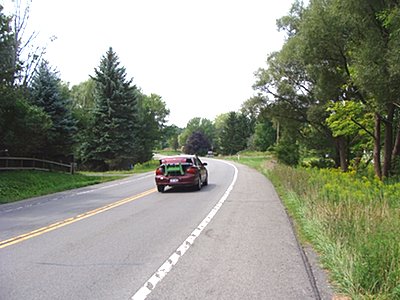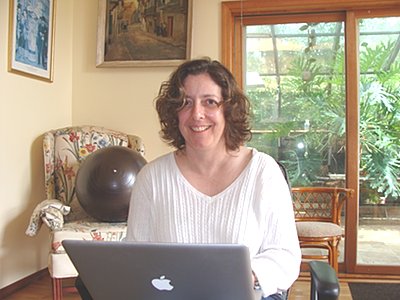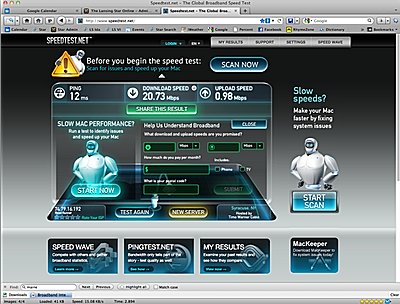- By Dan Veaner
- Around Town
 Print
Print  The absence of rural broadband isn't just a newspaper story about some remote part of the country in Tompkins County. It's a very real, very frustrating problem for some people who live so close to Time Warner's cable that they can just about smell it. Claire Perez is one of these people. She lives on Peruville Road in Dryden, just over a mile from the Lansing border. More importantly she is one sixth of a mile from the cable. It might as well be a thousand miles.
The absence of rural broadband isn't just a newspaper story about some remote part of the country in Tompkins County. It's a very real, very frustrating problem for some people who live so close to Time Warner's cable that they can just about smell it. Claire Perez is one of these people. She lives on Peruville Road in Dryden, just over a mile from the Lansing border. More importantly she is one sixth of a mile from the cable. It might as well be a thousand miles.
"Everything I do is pretty much online," she says. "I do my banking online, I look up health issues online. There are a lot of opportunities for me to do research and writing online. And looking for jobs online. That's been a real problem. Our tenants are always going to be dependent on online services. I am constantly thinking of the list of things I have to do online that I can't access."
Perez doesn't characterize herself as the kind of person who would become an activist. But her eight year saga of trying to get connected has led her to spend countless hours researching and writing in an online weblog (blog) titled 'it'saboutthestory'. Her blog entries are also hooked to Facebook, and Twitter, and a couple of blog aggregation sites. In addition she has started a Facebook Group called 'Bring Broadband to Peru....ville Road'.
A recent quote from Time Warner Cable Company says it would cost Perez $53,927 to connect to the cable. That is a connection fee to bring the cable from its current end .6 of a mile to Perez's house, not including the monthly service charges. She says she could recover some of that over a period of years, and she could also canvas her neighborhood to try to get others to pay a portion of the expense. But it is a lot of money for a sixth of a mile.
Interestingly, that number seems to be an arbitrary guess by the cable company. Unbeknownst to the Perezes, their tenants requested a quote around the same time. The rental house is on the same property as the Perezes' house, and the tenant received a quote of $48,927 within three days of the Perez's quote. She says another near neighbor recently received a quote in the $60,0000 range. And when she asked in 2003 when the cable was farther away than it is now, she remembers the quote as being significantly less, around the $10,000 range.
 So near and yet so far... the Time Warner cable comes only 0.6 miles away from this point on Peruville Road
So near and yet so far... the Time Warner cable comes only 0.6 miles away from this point on Peruville Road
Perez has talked to countless Time Warner representatives, as well as Dryden and Tompkins County representatives. One of those was Lansing's County Legislator, Pat Pryor, who chairs the county's Broadband Committee.
"She didn't think we'd have good Internet service for three to five years," Perez says. "That frustrated me. I read the committee's broadband report that they have on the Web. They said fiber to the home would meet broadband requirements very well, but would be expensive to deploy. But they didn't say how much it would cost."
Pryor's committee has been studying the issue since it was formed in August, 2010. As Pryor went door to door during her campaign it became obvious that Internet access was of major concern to her future constituents, and she decided to make that a priority if she were elected. As chairwoman of the Broadband Committee she has become something of an expert on the topic, and her committee has been collecting information they can use to come up with a report that the Legislature can use to reach a goal of universal FCC quality broadband service for 100% of Tompkins County. That is not going to come quickly.
"The primary impediment to universal access is cost," Pryor says. "History would suggest that if the state and federal government truly want to implement universal access as a goal, as they have said they do, they should treat broadband access much as electricity was treated in the 1930’s. Providers then were required to extend service because the service was considered to be fundamental to participation in the life and culture of that time. However, there does not appear to be any movement in the direction of government intervention currently at either the state or federal level. Therefore, if we accept the assumption that government will not require commercial providers to go beyond the industry’s return-on-investment standards then it becomes a question for local communities to determine if funding for the extension of broadband will become a local priority."
As the Internet has become more and more part of everyday life, the Perezes inability to get cable has become more and more of a hardship. Perez and her husband worry that they will not be able to keep tenants in their rental house, which is on the same property as their own home. She says they almost lost their current tenant, a Cornell graduate student researching artificial intelligence,because of slow Internet access.
To connect to the Internet they subscribe to Hughes.net, a satellite service, and she gets some Internet access on her cell phone. Their Hughes.net plan costs $65 per month, but only allows 200 megabytes (MB) of downloads per day. (In most cases what you get from the Internet isn't just displayed on your screen, but is first downloaded to your computer. Downloads are not just files that you decide to download from work, iTunes or a Web site. They include all the scripts and graphics your Web browser displays, email, sound files, video content, and so on.) The problem with her satellite plan is that after the first 100 MB Hughes throttles the speed to the point that Perez says makes it virtually unusable. Hughes calls this a 'Fair Access Policy'.
To put this in perspective, Perez's Hughes.net plan is advertised as having a 1.0mbps (megabits per second) download rate. While Time Warner positively obscures the hard numbers on download and upload rates their plans actually offer, their Road Runner Standard Internet plan tends to fall in the 7 Mbps to 10 Mbps range, depending on where in the country you receive their service, which currently goes for $29 per month for the first 12 months, and then jumps to $54.99, still less than the Hughes.net package. Both services offer higher priced plans with faster rates. Hughes.net offers one at $89.99 with a download speed 2mbps. Roadrunner Turbo is advertised at 15mbps, Broadband Extreme at 30mbps, and Wideband Internet at up to 50mbps. So the disparity in access for those within an area served by Time Warner and those that are not is significant.
 Claire Perez tries to get connected in her living room on Peruville Road
Claire Perez tries to get connected in her living room on Peruville Road
When Perez can't access the Internet via satellite she uses her cell phone. AT&T data plans cost $15 or $30 on top of the monthly charge for the phone. Speed is not good, and she can barely get a connection by bringing the phone to certain corners of her house. That means she can't even access her own blog from her home whenever she wants to. Instead she goes to the Lansing Library, 3.9 miles from her home, or sometimes to Barnes & Noble.
Perez likes to talk about $1.1 million Time Warner spent to lay 50 miles of fiber-optic and coaxial cable in on the islands of Vinalhaven and North Haven, and the Long Lake area of Madawaska, Maine. That comes to $22,000 per mile, and Time Warner says it will bring service to 267 rural communities serving potentially up to 1,200 customers. That comes to an average of $916.67 per customer, and an average of 24 customers per mile.
The New York State Public Service Commission specifies 35 houses per linear mile before they require the cable company to provide service. Perez says that is a 20 year old figure, and that Time Warner often goes with 20 houses per linear mile. She says that in her particular linear mile 15 houses may qualify. And while she admits that factors impacting the cost of laying cable vary, the difference between the $53,927 Time Warner wants her to shell out for .6 of a mile is significantly more than the $22,000 the company is paying themselves to hook up an area that includes two islands in Penobscot Bay, one just over 12 miles from the mainland and the other 15 miles.
She criticizes the State government for having disjointed broadband initiatives that don't look at the big picture.
"New York State received $160 million in grants," she notes. "But it doesn't seem like New York has come up with a comprehensive plan that is going to address the big picture. I find that very frustrating, because if you use the Time Warner figure from maine we could lay something like 8,000 miles of cable. That's from here to California almost three times."
On the local level the County Broadband Committee has set a goal of 100% connectivity, but the range of what that will mean in cost and the quality of the connection is likely to be expensive and varied.
 What's your Internet connection speed? Web sites like speedtest.net perform speed tests on your computer.
What's your Internet connection speed? Web sites like speedtest.net perform speed tests on your computer.
"The cost of investment to provide complete coverage could be huge depending on technology which dictate speed," says Hurf Sheldon, the Town of Lansing's representative on the Broadband Committee. Sheldon has been facing the same frustration as Perez for years, because his North Lansing home is outside of Time Warner's service area.
"How much bandwidth is 'enough' ?" he saks. "There are different technologies we are looking at – We are working on a matrix of investment , coverage, technology and funding scenarios. There is (as yet) no magic solution for everyone. Few people realize that Rural Electification took almost 20 years to complete. We think of it historically as instantaneous. Our working time frame is more like 36mos but that may be easier or harder. We have spoken with many private firms and one issue is onerous and expensive regulation and fees on the municipal level. Town governments are beginning to realize the social, economic and education benefits of broadband may dictate closer cooperation with installers. This could be a good quid-pro-quo issue when negotiating provider agreements."
That's a bandwagon Perez is getting on now. Dryden is about to renegotiate the terms of their Franchise Agreement with Time Warner, and she says the key to making any progress is to get as many citizens involved as possible. Dryden Town Councilman Jason Leifer is hosting a town meeting on September 6th at 7:30 in the Varna Community Center to talk about the town's franchise agreement, and to get input from residents on customer service and access requests. Perez is promoting the meeting on her blog, and says she is getting more aggressive about using the social media matrix to do so, as well as putting up posters to help get the word out.
"One thing I have learned throughout all this is how uninvolved we are in other corporate issues," she says. Because of that things happen that aren't necessarily in the citizens' best interest. I started blogging because I feel strongly about this and because I wanted to learn I thought it would be interesting to write about it as I learned. I hope through blogging I can reach a few more people in the next couple of weeks by using the social media matrix a little more aggressively."
That may accelerate the process of getting cable access a little, but probably only in spots, and not really soon. Pryor says that companies can't be expected to spend more on laying infrastructure unless they can get a reasonable return on their investment. That means that universal broadband in Tompkins County will have to be paid for by a combination of grants and local contributions. That means that getting high speed Internet access will depend on what town or village you live in and how much they are willing to contribute. She says a committee report to the Legislature on the assessment aspect of the charge should be forthcoming within the next 2 or 3 months.
"So, the answer to the question of 'when' depends on where you live," Pryor says. "If you happen to live in a rural area where housing density is increasing rapidly or in a town that is actively moving to improve access it will happen sooner. If not, it’s going to take longer and I don’t think anyone can say at this point how much longer. It will up to the community to determine whether its priorities will include the will to make the investment that will be required to attract grant funding to assist in covering the costs of universal access."
v7i34



